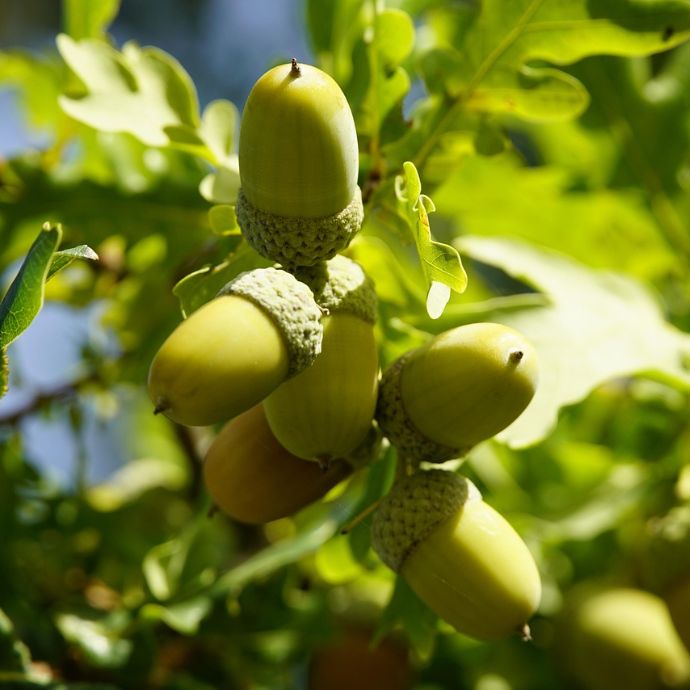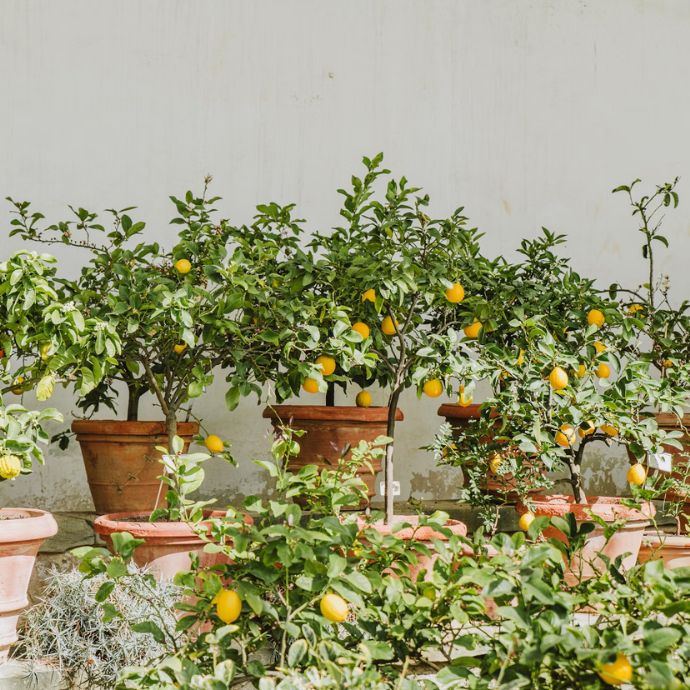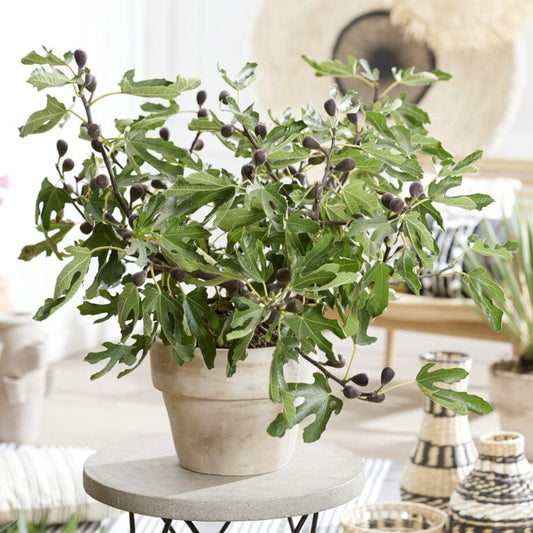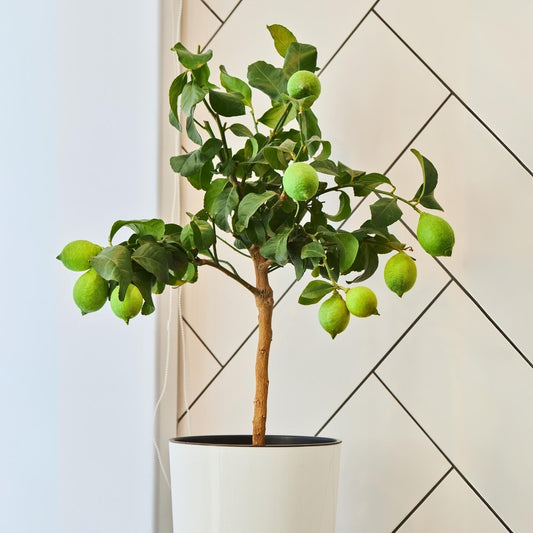Fruit Tree Problems: Signs and Solutions
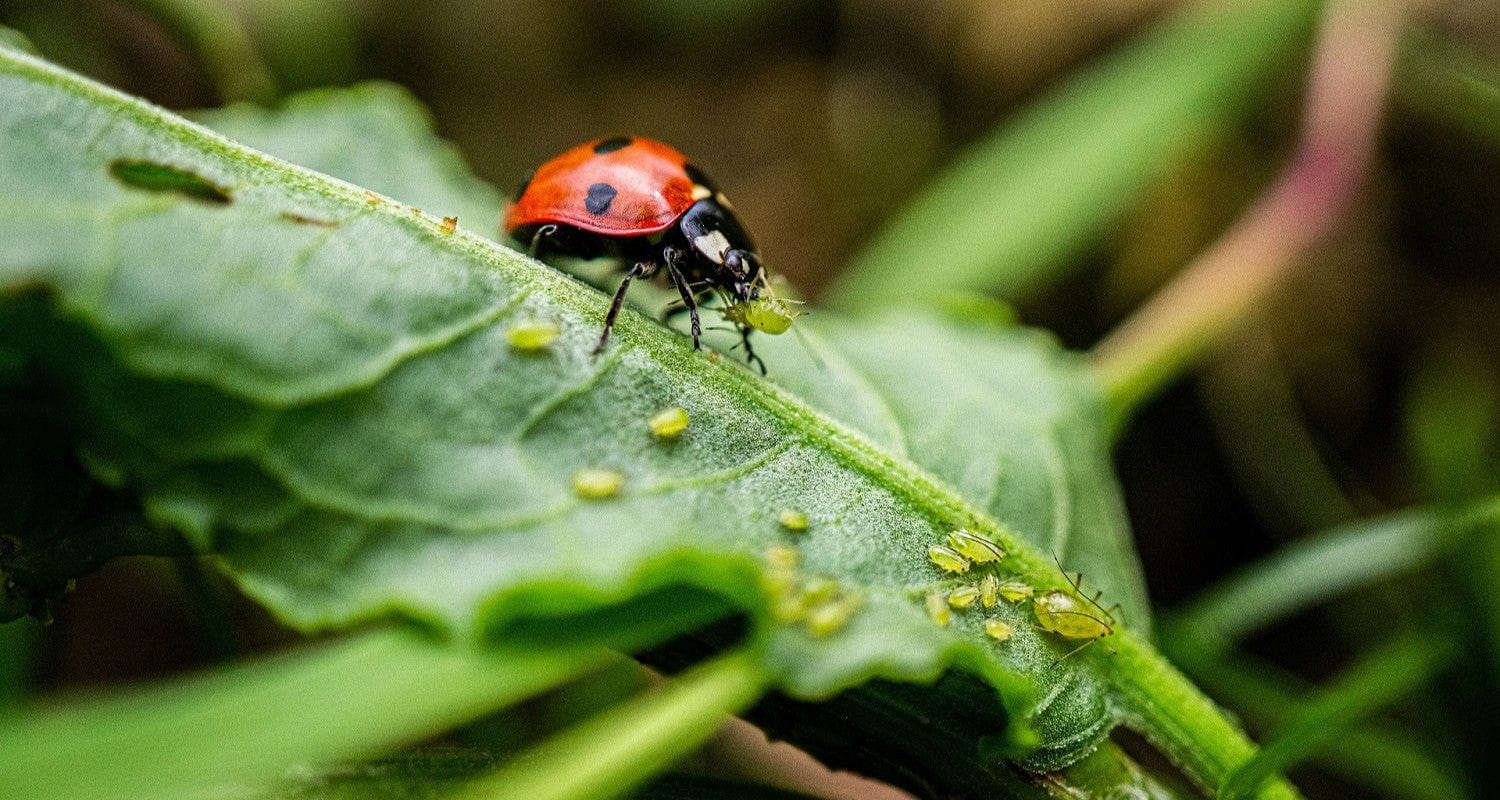
If you plant your fruit tree in a good position, water and feed it regularly and keep it well pruned, you should very rarely encounter any problems. But what happens when fruit trees go wrong? Even the most resilient of them can sometimes be affected by pests or diseases and if they do, it’s vital to recognise the symptoms so you can act quickly.
Don’t worry - most can be prevented or fixed! In this article we show you how to identify and deal with the most common fruit tree pests and diseases yourself - or avoid them in the first place.
Jump to:
General fruit trees
Apples and pears
Stone fruits
- Bacterial canker
- Peach leaf curl
- Silver leaf
- Brown scale
- Glasshouse red spider mite
- Pigeons
- Slugs and snails
Soft fruits
Common fruit tree diseases
Common fruit tree diseases include moulds, cankers, root rot and mildews. Their effects can range from the unsightly to the downright dangerous and it’s important to keep a close eye on your trees in order to catch any diseases in the early stages. Read on to find out the best ways of dealing with these common diseases.
Apple scab
Uglifying apples since 1462, this disease hits hardest in areas with heavy rainfall.
Which trees it affects
Apples, crabapples and pears.
What it looks like
Khaki green, velvet-textured blotches on the leaves which get darker over time. The leaves might drop, twigs may look blistered or cracked and brown or black patches (scabs) might appear on the fruit.

Image credit: Luke Milliron.
What it does to your tree
Minor attacks of apple scab will give you ugly looking apples, but they can still be eaten - unfortunately they won’t store as well, so if you have a glut you’ll need to cook and freeze them.
If the scabs split to form lesions, the fruit will need to be removed straight away as these can let other infections in.
How to get rid of it
Prune away infected twigs and leaves then destroy them (don’t put them on the compost heap). The spores spread through fallen leaves into the soil, so make sure you pick up and destroy them all as soon as they fall.
Apple canker
Affects trees in heavy, wet or acidic soil.
Which trees it affects
Apples and pears. There’s a separate canker that affects plums and cherries in much the same way.
What it looks like
Cankers look like flaky, sunken craters. Sometimes the wood will look swollen around them.

Image credit: Wikimedia.
What it does to your tree
Branches die back and occasionally the fruit will rot and fall off.
How to get rid of it
Cut out all the infected parts when you’re doing your winter pruning, cutting well back to fresh green wood. You can prevent canker by adding lime to the soil to reduce its acidity and perlite/horticultural grit to improve drainage.
Bacterial canker
Affects trees of the Prunus family, leaving them looking like there’s been a gunfight.
Which trees it affects
Plums, cherries, apricots and peaches.
What it looks like
You’ll see sunken patches of dead bark (sometimes oozing gum - although gum on its own is not a symptom) and small holes in the leaves.
What it does to your tree
Shoots may fail to appear, or die back. If the disease spreads, the whole branch will die. The leaf holes will get bigger, looking like they’ve been shot.
How to get rid of it
In July or August, cut out all cankered parts of the tree and paint with wound paint. For the love of all that’s holy don’t compost the prunings.
Blossom wilt
A fungal disease of trees that makes its baleful appearance at blossom time.
Which trees it affects
All of them.
What it looks like
Shrivelled, brown blossom, small brown pustules of fungi on the dead vegetation. You may see brown rotted fruit in the advanced stages.
What it does to your tree
If blossom dies, the tree may not be pollinated and may not fruit. The shoots may also die back, and fruit become infected with brown rot. It may kill small branches.
How to get rid of it
Remove brown, rotted fruit as soon as it appears. Prune out the infected spurs and blossoms, and dispose of them in your black bin or by burning.
Brown rot
The blossom wilt fungi (Monilinia laxa and M. fructigena) just keep on giving - they also cause this fruit-spoiling disease.
Which trees it affects
All of them.
What it looks like
Brown, spreading rot in the fruit - it gets in via wounds made by birds, insects or apple scab infections and spreads among clusters of fruit.

Image credit: Peter Häger.
What it does to your tree
Fruit falls off or remains on the tree in a mummified state.
How to get rid of it
Stop it spreading by removing and disposing of affected fruit straight away. You might also want to net your tree to prevent bird damage.
Coral spot
Another fungal disease which causes branches to die back.
Which trees it affects
Figs.
What it looks like
The affected wood dies and then coral pink, raised spots appear.

Image credit: Gail Hampshire.
What it does to your tree
Coral spot is a pretty pathetic pathogen which doesn’t tend to affect trees unless they’ve already been weakened by something stronger and nastier. Once it sets in though, it attacks the weakened wood, causing it to die back. It’s often a sign that you need to check your tree for other diseases.
How to get rid of it
Prevention is better than cure - to avoid Coral Spot, only ever prune your trees in dry weather, cutting out any infected parts promptly, back to healthy wood. Dispose of the pruned branches in your garden waste rather than letting them sit around generating spores.
Fireblight
Fireblight is at large from spring to early autumn, caused by the Erwinia amylovora bacteria.
Which trees it affects
Apples and pears.
What it looks like
You might see wilted or dead blossoms, white ooze coming from infected parts in wet weather, shrivelled and dying shoots and cankers (areas of sunken, dead wood) - in short, a mess.

Image credit: Wikimedia.
What it does to your tree
Probably needless to say that affected trees won’t produce any fruit - the tree ends up looking like it’s been scorched by fire.
How to get rid of it
The affected parts of the tree need to be pruned out and burned, and the pruning tools disinfected between each cut to avoid the disease spreading. Any late blossoms should be removed. Fireblight sometimes comes from Hawthorn hedges, so these should be avoided by serious fruit growers.
Grey mould
Grey mould is a result of humid conditions, but it can be prevented with a little regular attention.
Which trees it affects
Usually this is more of a problem with soft fruits like strawberries, raspberries and blackberries, but if you’re growing fruit trees under cover you should watch out for grey mould too.
What it looks like
Furry grey-brown mould patches develop on rotting parts of the plant, especially the fruits.
What it does to your tree
Rots the above-ground parts of the plant, causing it to shrivel and die and fruit to go mouldy. Spreads like nobody’s business in high humidity.
How to get rid of it
Ventilation, ventilation, ventilation. It’s vital to keep a good flow of air around your plants, so if you’re growing in a greenhouse or similar, open the windows regularly. Any affected parts of the plants should be removed and destroyed ASAP.
Peach leaf curl
The scourge of every peach gardener, but there are resistant varieties you can plant.
Which trees it affects
Peaches, nectarines, almonds and occasionally apricots.
What it looks like
One thing you can say for this disease is that it does exactly what it says. Leaves curl and twist up, develop white fungal bloom and drop off.

Image credit: Wikimedia.
What it does to your tree
Looks deeply unpleasant and weakens the tree.
How to get rid of it
Protecting your tree from frost from November to March will help, as the covering keeps the emerging shoots dry and free from infection. Some varieties are resistant to it, including Peregrine, Red Haven (good resistance) and Avalon Pride (completely resistant). If you do see the leaves curling up and suspect Leaf Curl, remove them as soon as possible, before the spores emerge.
Powdery mildew
Fungal disease that’s a curse in the veg garden but can also affect fruit trees.
Which trees it affects
Apples.
What it looks like
A white, powdery coating on the upper side of the leaves and sometimes the blossom. The leaves might look smaller or misshapen and they may fall early.

Image credit: BlueRidgeKitties.
What it does to your tree
Weakens the tree, allowing other infections to take hold. If it spreads to the blossom, this will reduce your crop of fruit.
How to get rid of it
Prune out the affected parts in summer and make sure you pick up all the fallen leaves in autumn, as the infection spreads through soil. You can prevent powdery mildew by spacing your trees well and not overcrowding your beds. Pruning your apple tree every year will also encourage good air circulation through the branches. If there’s a long dry spell, make sure you water your tree well as mildew hits worse when the soil dries out.
Silver leaf
This fungal disease usually gets in through pruning wounds and appears in summer.
Which trees it affects
Plums, apples, apricots, almonds and cherries.
What it looks like
The leaves will develop a silvery sheen (easiest to detect on plums) before the wood dies back. Make sure it definitely is silver leaf rather than stress from drought or cold, by cutting an affected branch. If it is silver leaf, the wood will have a dark brown stain in the centre.
What it does to your tree
Affected branches will die.
How to get rid of it
Cut out the affected wood and burn it, disinfecting your pruners between each cut. To prevent silver leaf, prune your trees in summer when there aren’t as many of the spores about.
Common fruit tree pests
Common fruit tree pests include aphids, slugs and pigeons. In the first instance we would always recommend trying natural pest control methods such as oil or soap sprays, companion planting and encouraging predators that feed on pests. Read on for specific advice for each of these annoying beasts.
Aphids (blackfly, greenfly and others)
Aphids are sap sucking insects that you may know as greenfly or blackfly.
Which trees they affect
All of them.
What they look like
Little green or brown bugs (1-7mm long) clinging to flower buds, shoots and under leaves.

What they do to your tree
Suck sap out of it, causing stunted growth, and excrete a sticky ‘dew’ that encourages mould.
How to get rid of them
Squash them if you can bear to, spray with soap/oil sprays or encourage their predators (ladybirds, hoverflies, lacewings and parasitoid wasps).
Brown scale
A sap-sucking insect that’s active all year round and affects woody plants.
Which trees they affect
Plums, peaches, nectarines, grape vines, bush and cane fruits.
What they look like
Dark brown shell shaped insects 3-6mm long, usually found on woody stems.

Image credit: Wikimedia.
What they do to your tree
Suck sap out of it, causing stunted growth, and excrete a sticky ‘dew’ that encourages mould.
How to get rid of them
Spray with soap/oil sprays or encourage their predators (ladybirds, hoverflies, lacewings and parasitoid wasps). If that doesn’t work, use the nematode Steinernema feltiae - this can be bought online.
Glasshouse red spider mite
Sap sucking mites that mainly affect greenhouse plants but can be active in the garden in summer.
Which trees they affect
Peaches and nectarines.
What they look like
Tiny yellow-green (not red!) mites with two dark patches. You might find them on the underside of leaves, or see a fine silk webbing on your plants.

Image credit: Wikimedia.
What they do to your tree
They suck the sap from plants, causing leaves to drop or become mottled. In severe cases they can kill the plant.
How to get rid of them
Regularly spray your greenhouse plants with water and keep the humidity high. Try introducing predators, namely the mite Phytoseiulus persimilis, the midge Amblyseius (Feltiella acrarsuga) and the Atheta coriaria beetle, which can be bought online.
Pigeons
Everyone’s least favourite garden bird, pigeons can devastate a stone fruit crop.
Which trees they affect
Cherries, plums, peaches and nectarines.
What they look like
Flapping beady-eyed harbingers of plant doom.

What they do to your tree
Pigeons will eat young leaves and buds of trees. Then they’ll come back for the fruit. If the buds are seriously damaged, the tree will produce minimal or no fruit.
How to get rid of them
When fruits appear, cover them with netting. You can also try movement-activated sprinklers or scarecrows. Or get a cat.
Rabbits
If you live near fields, farms or woodland, you may have a problem with these fluffy pests.
Which trees they affect
All of them except cherries for some reason.
What they look like
Cute but evil. Just ask Mr McGregor.

What they do to your tree
Eat shoot tips, foliage, bark and even low-hanging fruit (they can reach a height of 50cm by standing on their hind legs). The bark-stripping can kill a tree.
How to get rid of them
Make your garden fences rabbit-proof by using wire mesh or netting. You can also put netting or tree guards around vulnerable trees. You can get repellant sprays but we don’t recommend using them around fruit trees, as they have a bitter taste.
Squirrels
You may have a problem with these furry scroungers if you live near woodland.
Which trees they affect
All of them.
What they look like
Big fluffy tails, chubby little faces and cute acrobatics conceal sheer malevolence.

What they do to your tree
Strip the bark, climb up the trunk and eat the fruits.
How to get rid of them
Cover emerging fruits with netting, use tree guards or sticky bands to stop them climbing. Don’t hang bird feeders near your fruit trees.
Scale insects
There seems to be a sap-sucking scale insect for every kind of plant - unfortunately that includes fruit trees.
Which trees they affect
All of them.
What they look like
‘Scale insects’ covers many species, ranging from 1mm-1cm in size. They all leave scale or shell-like bumps on stems and under leaves.
What they do to your tree
Stunt the growth. Some species excrete honeydew, which can lead to black mould developing.
How to get rid of them
Spray with soap/oil sprays or encourage their predators (birds, ladybirds and parasitoid wasps) If that doesn’t work, use the nematode Steinernema feltiae - this can be bought online.
Slugs and snails
Gardening enemy #1. The only way to beat them is constant vigilance!
Which trees they affect
Stone fruits are most affected, along with any low hanging fruit.
What they look like
Slimy brown or black molluscs of any size that leave a distinctive slime trail. Snails, as above but with a shell.

What they do to your tree
Slugs and snails will slime their way up trees to take bites out of the fruit.
How to get rid of them
Go round at night with a torch, picking them off. Try making a barrier around your tree with copper wire or old pennies, crushed seashells or fine gravel. You can also set traps with scooped out orange skins or dishes of beer. Failing that, try the nematode Phasmarhabditis hermaphrodita.
Winter moth caterpillars
There are many species of winter caterpillars, and they’re a scourge of fruit trees in early spring.
Which trees they affect
All of them, particularly apples, pears, plums and cherries.
What they look like
You might see the caterpillars feeding on emerging leaves. If you don’t, you’ll certainly see the holes in the leaves they’ve eaten.

Image credit: Patrick Clement.
What they do to your tree
Nibble holes in the leaves, blossom and developing fruits. This can weaken young trees, affecting the quality and quantity of fruit.
How to get rid of them
Pick them off, or encourage predators including hedgehogs, birds (especially tits) and ground beetles. A sticky band around the tree trunk may also be effective.
Last updated: 13/11/2023









